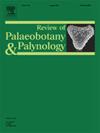Stellula meridionalis gen. et sp. nov., the oldest fossil flower from the Early Cretaceous of Argentina
IF 1.7
3区 地球科学
Q2 PALEONTOLOGY
引用次数: 0
Abstract
In this contribution, we describe a novel angiosperm floral axis, Stellula meridionalis gen. et sp. nov., consisting of a botryoid inflorescence, from the upper Aptian La Cantera Formation, San Luis Basin, central-western Argentina. Flowers are small, sessile and arranged distally on the inflorescences. Some specimens were found organically associated with leaves of “LC-Microphyll trifoliate”, a previously described and published fossil taxon. The leaves are nanophyllous, petiolate, with pinnately lobed or toothed margins, and the apex isn't preserved. Morphological features, such as pinnately lobed or toothed leaves with glandular margins, small trimerous actinomorphic flowers with floral organs in whorls, suggest an affinity with an early lineage of eudicots, likely within the Ranunculales. However, the absence of in situ pollen prevents definitive systematic assignment of the new taxon. Pollen analyses of dispersed taxa recovered from the same stratigraphic interval have revealed diverse angiosperm families, underscoring the complexity and increasing diversity of angiosperms in the mid-latitudes of South America during the Early Cretaceous.
Stellula meridionalis gen. et sp. nov.,阿根廷早白垩纪最古老的花化石
在这篇论文中,我们描述了一种新的被子植物花轴,Stellula meridionalis gen. et sp. nov.,由一个植物状花序组成,来自阿根廷中西部圣路易斯盆地Aptian La Cantera组上部。花小,无梗,上部排列在花序上。一些标本被发现与“lc - microphyl trifoliate”的叶片有机关联,这是一个先前描述和发表的化石分类单元。叶具纳米叶,叶柄,边缘具羽状浅裂或齿状,先端未保存。形态学特征,如羽状裂叶或齿状叶,边缘具腺,小的三分体放射线形花,花器官在轮生中,表明其与早期毛茛属植物的亲缘关系,可能属于毛茛属植物。然而,原位花粉的缺失阻碍了新分类单元的确定系统分配。对同一地层间隔中分散分类群的花粉分析揭示了被子植物科的多样性,强调了早白垩世南美洲中纬度地区被子植物的复杂性和日益增加的多样性。
本文章由计算机程序翻译,如有差异,请以英文原文为准。
求助全文
约1分钟内获得全文
求助全文
来源期刊
CiteScore
3.50
自引率
21.10%
发文量
149
审稿时长
6 months
期刊介绍:
The Review of Palaeobotany and Palynology is an international journal for articles in all fields of palaeobotany and palynology dealing with all groups, ranging from marine palynomorphs to higher land plants. Original contributions and comprehensive review papers should appeal to an international audience. Typical topics include but are not restricted to systematics, evolution, palaeobiology, palaeoecology, biostratigraphy, biochronology, palaeoclimatology, paleogeography, taphonomy, palaeoenvironmental reconstructions, vegetation history, and practical applications of palaeobotany and palynology, e.g. in coal and petroleum geology and archaeology. The journal especially encourages the publication of articles in which palaeobotany and palynology are applied for solving fundamental geological and biological problems as well as innovative and interdisciplinary approaches.

 求助内容:
求助内容: 应助结果提醒方式:
应助结果提醒方式:


